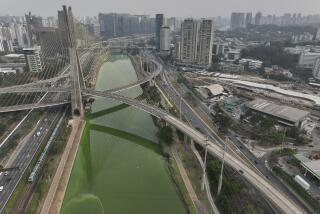Agricultural Fires Create South Pacific Smog, Study Says
Huge man-made fires in Asia, Africa, Australia and South America are generating so much smoke that skies over some remote South Pacific islands now have smog at levels that resemble those found in Los Angeles, according to a research paper by Nobel laureate F. Sherwood Rowland of UC Irvine.
Rowland, winner of the 1995 Nobel Prize in chemistry, and his co-author, Donald Blake, also of UC Irvine, based their findings on a series of 1996 research flights that, for the first time, measured unhealthful levels of smog-forming ozone over a vast area of the South Pacific, including such remote and exotic places as Tahiti, Fiji, Easter Island, Ascension Island and the Galapagos Islands.
The research flights detected significant levels of smog in a vast area of some 5 million square miles, most of which is thousands of miles from sources of pollution, Blake said.
On several occasions, ozone was measured at 130 ppb, a level that exceeds the U.S. government’s threshold for unhealthy air.
Rowland is scheduled to present the paper today in Dallas at the national meeting of the American Chemical Society.
In the past, “satellites had shown some enhanced ozone in the South Pacific,” Blake said. “But what came as a surprise was the extent of it and the fact that it traveled for such great distances. We would have thought it would have dispersed more than it did.”
Elliot Atlas, a scientist with the National Center for Atmospheric Research, said: “It was a revelation to see how widespread the effects of the burning are across areas of the atmosphere previously thought to be pretty pristine.”
A blessing and a curse, ozone plays a dual role in Earth’s environment.
At 10 to 30 miles above the Earth’s surface, naturally occurring ozone plays a critical role of filtering out harmful ultraviolet rays from the sun.
Rowland’s Nobel Prize, which he shared with professor Mario J. Molina of the Massachusetts Institute of Technology, involved that role of ozone. He studied how chlorofluorocarbons--chemicals once widely used for refrigeration and as a propellant in spray cans but now being phased out worldwide--could destroy the atmosphere’s ozone shield.
But close to the ground, where it usually is the result of human activities, ozone is a significant pollutant--the chief component of smog--that can seriously harm the human respiratory system.
The smog research was carried out by a team of scientists sponsored by NASA and included experts from the National Center for Atmospheric Research and the National Oceanographic and Atmospheric Administration.
The scientists traced the pollutants to massive agricultural burning in parts of the world where people are clearing brush and woodlands in order to plant crops and graze cattle.
Known as slash-and-burn agriculture, the burning is also a major cause of worldwide deforestation.
The research flights predated the past year’s fire season, which has been one of the worst ever in large parts of south Asia because of droughts associated with El Nino. The research will resume in 1999 to measure whether the ozone concentrations have worsened.
The researchers concluded that the burning was the cause of the pollution, said Blake, because they found no evidence of emissions from industry or motor vehicles. The researchers found higher levels of smog above the ocean than near the site of the burning, Blake said.
That is because ozone is a secondary product of combustion--formed in the air as other, primary gases interact--sometimes miles away from the source of combustion.
“We have seen that in Southern California, where the air can be worse in Riverside and Redlands than it is in L.A., nearer the source of the emissions,” Blake said. “Now we’re discovering a similar pattern, only in this case it’s thousands of miles from the sources.”
The impact on human health of the new ozone findings is unclear. The research flights directly measured ozone levels two to five miles above the surface, not at ground level where people can breathe it.
But “what goes up tends to come down,” Blake said. Ozone above the surface “eventually can mix in with ambient air that people breathe.”






